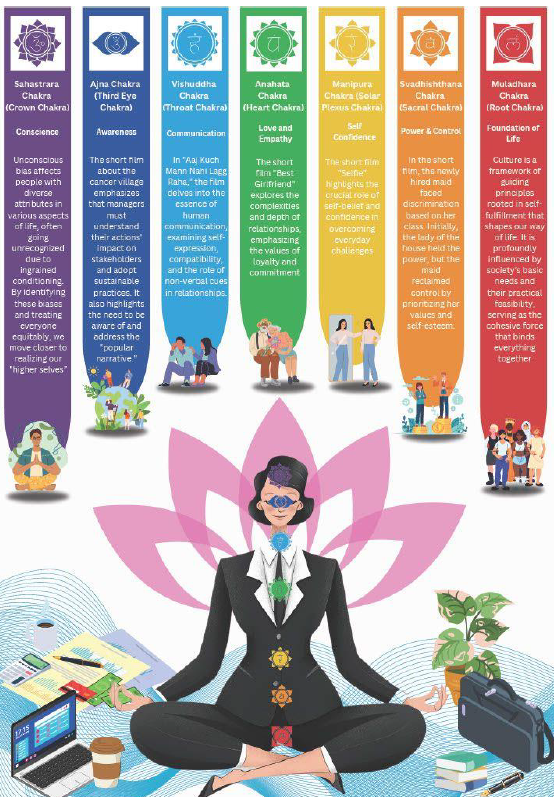
Design Thinking in Teaching Business Communication in an MBA Program in India
Introduction
Teaching Business Communication to MBA students presents a unique challenge: the subject combines practical skills with conceptual depth, requiring an innovative approach to maintain engagement while imparting core competencies. In an Indian context, design thinking—a problem- solving approach that emphasizes empathy, ideation, and iteration—provides a powerful pedagogical tool for Business Communication education. Drawing from Indian cultural values and traditional wisdom, this approach can be further enriched and aligned with the concept of Globalizing Indian Thought. By integrating elements from Indian culture and contemporary design thinking methodologies, educators can create an impactful and culturally resonant learning experience.
Design Thinking and Indian Cultural Elements
Design thinking centers on empathy and understanding user needs, which aligns closely with Indian cultural values, such as interconnectedness and empathy. These values are symbolized in ancient Indian practices, like the chakras (energy centers), each representing essential human virtues such as awareness, empathy, and communication, as depicted in the provided poster. This alignment between design thinking principles and Indian wisdom offers an authentic foundation for teaching communication skills.

For instance, the Anahata Chakra (Heart Chakra), associated with love and empathy, emphasizes emotional resonance in communication—essential for understanding audience needs. Similarly, the Vishuddha Chakra (Throat Chakra) represents communication and expression, which are fundamental to effective public speaking and interaction in a business context. These traditional symbols help students appreciate the holistic aspect of communication, where effective business interactions require both intellectual and emotional intelligence.
Applying Design Thinking to Business Communication
The experience shared—where students created a visual narrative combining all class concepts— reflects the essence of design thinking: finding patterns in chaos, iterating ideas, and collaboratively building meaning. The project-based assignment encourages students to apply creative problem- solving to synthesize and communicate complex ideas effectively, mirroring real-world business scenarios.
Empathy in Listening and Speaking: Through activities inspired by the Anahata Chakra, students learn to empathize with diverse perspectives, enhancing their listening skills. Empathy-based exercises, such as practicing active listening or role-playing customer interactions, build emotional intelligence and social competence—skills critical to modern business communication.
Visualization for Clarity: Instructing students to create visual representations of concepts—like the poster assignment—helps them to connect abstract ideas, making the learning process more tangible. Such exercises also leverage the Ajna Chakra (Third Eye Chakra), associated with insight and awareness, fostering an intuitive understanding of how ideas interconnect in complex narratives.
Iterative Communication Skills: The process of revising and refining their posters or presentations encourages students to embrace iteration, a core principle of design thinking. This iterative approach not only enhances their communicative competence but also aligns with the Manipura Chakra (Solar Plexus Chakra), which represents confidence and self-assurance—traits essential for public speaking.
Integration of Feedback: Incorporating peer feedback allows students to view communication as a collaborative, evolving process rather than a one-time performance. This process encourages self- reflection, aligning with the Svadhishthana Chakra (Sacral Chakra), which emphasizes adaptability and personal growth.
Blending Tradition with Modern Pedagogical Innovation
Incorporating design thinking within a framework that acknowledges Indian cultural symbols provides students with a unique blend of traditional wisdom and modern pedagogical innovation. This blend resonates with India’s philosophy of Vasudhaiva Kutumbakam (the world is one family), encouraging a global perspective grounded in Indian values. Through projects that require both analytical and creative skills, such as poster creation and group presentations, students develop a holistic approach to communication, preparing them for the complexities of global business.
The pedagogical benefits of this approach include:
Enhanced Engagement: Students find relevance in the material, as they relate the course concepts to familiar cultural symbols.
Holistic Skill Development: Students gain not only technical communication skills but also emotional and social competencies.
Adaptability to Real-World Scenarios: Through projects that involve collaboration, visualization, and empathy, students develop skills that are directly applicable to real-world business communication challenges.
Conclusion
By using design thinking enriched with Indian cultural elements, Business Communication educators in Indian MBA programs can offer a learning experience that is engaging, culturally relevant, and globally applicable. This approach not only reinforces communication skills but also instills values such as empathy, self-awareness, and adaptability—preparing students to navigate the complexities of modern business with a well-rounded perspective. The integration of these traditional and innovative elements exemplifies the philosophy of Globalizing Indian Thought, positioning students to become thoughtful, effective communicators on a global stage